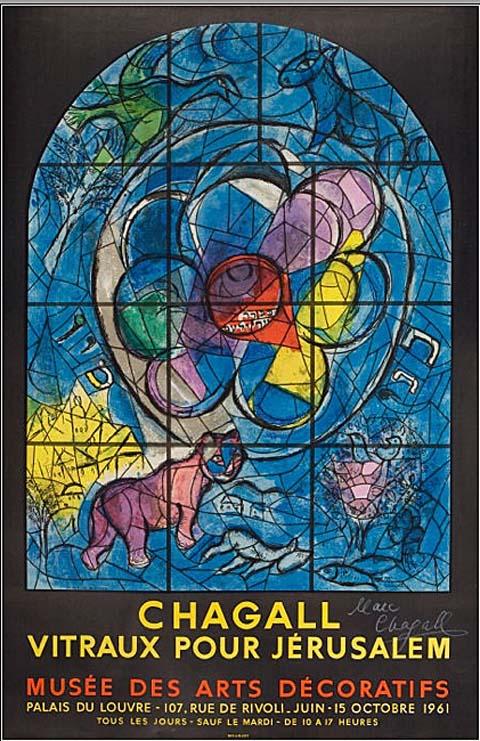French translation: Windows for Jerusalem
Curator' note: Chagall designed the stained glass window. He may or may not have designed the poster
One of Chagall's major contributions to art has been his work with stained glass. This medium allowed him to further express his desire to create intense and fresh colors and had the added benefit of natural light and refraction interacting and constantly changing. Everything from the position where the viewer stood to the weather outside would alter the visual effect. It was not until 1956, when he was nearly 70 years of age, that he designed windows for the church at Assy, his first major project. Then, from 1958 to 1960, he created windows for the Metz Cathedral.
Jerusalem Windows (1962)
In 1960, he began creating stained glass windows for the synagogue of Hebrew University's Hadassah Medical Center in Jerusalem. Leymarie writes that "in order to iluminate the synagogue both spiritually and physically", it was decided that the twelve windows, representing the twelve tribes of Israel, were to be filled with stained glass. Chagall envisaged the synagogue as "a crown offered to the Jewish Queen", and the windows as "jewels of translucent fire", she writes. Chagall then devoted the next two years to the task, and upon completion in 1961 the windows were exhibited in Paris and then the Museum of Modern Art in New York. They were installed permanently in Jerusalem in February 1962.
Each of the twelve windows is approximately ll feet high and 8 feet (2.4 m) wide, much larger than anything he had done before. Cogniat considers them to be "his greatest work in the field of stained glass", although Virginia Haggard McNeil records Chagall's disappointment that they were to be lit with artificial light, and so would not change according to the conditions of natural light.
French philosopher Gaston Bachelard commented that "Chagall reads the Bible and suddenly the passages become light."[16]:xii In 1973 Israel released a 12-stamp set with images of the stained-glass windows (see image).
The windows symbolize the twelve tribes of Israel who were blessed by Jacob and Moses in the verses which conclude Genesis and Deuteronomy. In those books, notes Leymarie, "The dying Moses repeated Jacob's solemn act and, in a somewhat different order, also blessed the twelve tribes of Israel who were about to enter the land of Canaan... In the synagogue, where the windows are distributed in the same way, the tribes form a symbolic guard of honor around the tabernacle."
Leymarie describes the physical and spiritual significance of the windows:
The essence of the Jerusalem Windows lies in color, in Chagall's magical ability to animate material and transform it into light. Words do not have the power to describe Chagall's color, its spirituality, its singing quality, its dazzling luminosity, its ever more subtle flow, and its sensitivity to the inflections of the soul and the transports of the imagination. It is simultaneously jewel-hard and foamy, reverberating and penetrating, radiating light from an unknown interior.
At the dedication ceremony in 1962, Chagall described his feelings about the windows:
"For me a stained glass window is a transparent partition between my heart and the heart of the world. Stained glass has to be serious and passionate. It is something elevating and exhilarating. It has to live through the perception of light. To read the Bible is to perceive a certain light, and the window has to make this obvious through its simplicity and grace... The thoughts have nested in me for many years, since the time when my feet walked on the Holy Land, when I prepared myself to create engravings of the Bible. They strengthened me and encouraged me to bring my modest gift to the Jewish people—that people that lived here thousands of years ago, among the other Semitic peoples."
Source: Wikipedia

